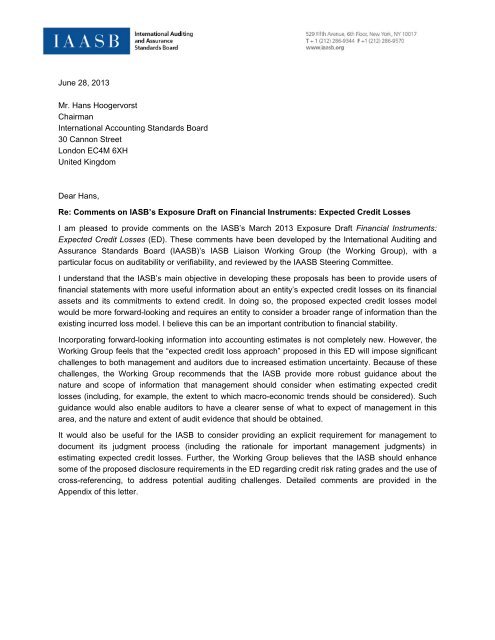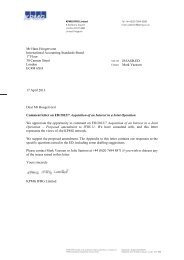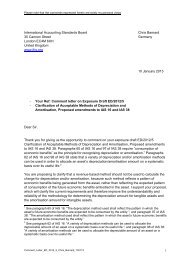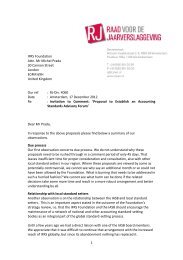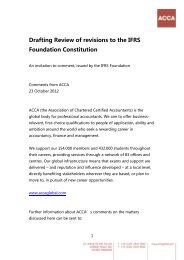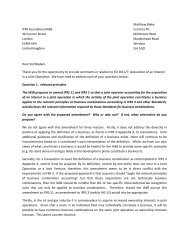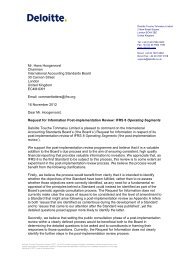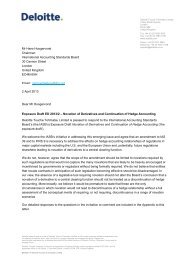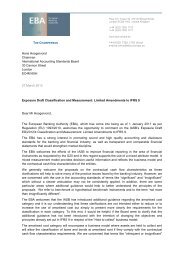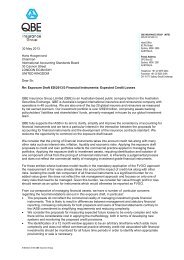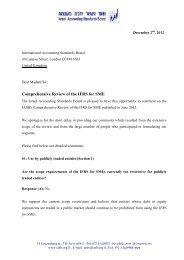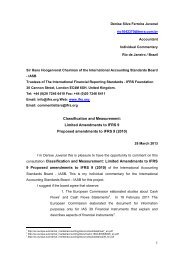Expected Credit Losses - IFAC
Expected Credit Losses - IFAC
Expected Credit Losses - IFAC
- No tags were found...
You also want an ePaper? Increase the reach of your titles
YUMPU automatically turns print PDFs into web optimized ePapers that Google loves.
June 28, 2013Mr. Hans HoogervorstChairmanInternational Accounting Standards Board30 Cannon StreetLondon EC4M 6XHUnited KingdomDear Hans,Re: Comments on IASB’s Exposure Draft on Financial Instruments: <strong>Expected</strong> <strong>Credit</strong> <strong>Losses</strong>I am pleased to provide comments on the IASB’s March 2013 Exposure Draft Financial Instruments:<strong>Expected</strong> <strong>Credit</strong> <strong>Losses</strong> (ED). These comments have been developed by the International Auditing andAssurance Standards Board (IAASB)’s IASB Liaison Working Group (the Working Group), with aparticular focus on auditability or verifiability, and reviewed by the IAASB Steering Committee.I understand that the IASB’s main objective in developing these proposals has been to provide users offinancial statements with more useful information about an entity’s expected credit losses on its financialassets and its commitments to extend credit. In doing so, the proposed expected credit losses modelwould be more forward-looking and requires an entity to consider a broader range of information than theexisting incurred loss model. I believe this can be an important contribution to financial stability.Incorporating forward-looking information into accounting estimates is not completely new. However, theWorking Group feels that the “expected credit loss approach” proposed in this ED will impose significantchallenges to both management and auditors due to increased estimation uncertainty. Because of thesechallenges, the Working Group recommends that the IASB provide more robust guidance about thenature and scope of information that management should consider when estimating expected creditlosses (including, for example, the extent to which macro-economic trends should be considered). Suchguidance would also enable auditors to have a clearer sense of what to expect of management in thisarea, and the nature and extent of audit evidence that should be obtained.It would also be useful for the IASB to consider providing an explicit requirement for management todocument its judgment process (including the rationale for important management judgments) inestimating expected credit losses. Further, the Working Group believes that the IASB should enhancesome of the proposed disclosure requirements in the ED regarding credit risk rating grades and the use ofcross-referencing, to address potential auditing challenges. Detailed comments are provided in theAppendix of this letter.
I hope that you will find the comments helpful. If you require any clarification or would like to discuss thisletter further, please do not hesitate to contact me or Mr. Tomokazu Sekiguchi, the Chair of the WorkingGroup (t.sekiguchi@asb.or.jp).Yours sincerely,Prof. Arnold SchilderChairman, IAASBCc.Mr. Prabhakar Kalavacherla, Member and Liaison Representative, IASB2
IASB EXPOSURE DRAFT -FINANCIAL INSTRUMENTS: EXPECTED CREDIT LOSSESComments of the IAASB’s Working GroupAppendixI. OVERALL COMMENTSCHALLENGES FOR MANAGEMENT AND AUDITORS RELATING TO INCREASED ESTIMATIONUNCERTAINTYIssues DescriptionThe ED proposes to introduce the “expected loss approach” to replace the “incurred loss approach” in theexisting IAS 39 Financial Instruments: Recognition and Measurement. The ED also proposes to requirean entity to estimate the lifetime expected credit losses for a purchased or originated credit-impairedfinancial asset, and for a financial instrument of which the credit risk has increased significantly sinceinitial recognition. Such a requirement would introduce a high level of estimation uncertainty, and requiremanagement to exercise significant judgment when estimating the expected credit losses. For auditors,obtaining sufficient appropriate audit evidence relating to those judgments would become morechallenging.Under the International Standards of Auditing 1 (ISAs), for accounting estimates that give rise to significantrisks, among others, the auditor shall evaluate the following:(a) How management has considered alternative assumptions or outcomes, and why it has rejectedthem, or how management has otherwise addressed estimation uncertainty in making the accountingestimate;(b) Whether the significant assumptions used by management are reasonable; and(c) Where relevant to the reasonableness of the significant assumptions used by management or theappropriate application of the applicable financial reporting framework, management’s intent to carryout specific courses of action and its ability to do so.In addition, if the auditor determines that an accounting estimate gives rise to a significant risk, the auditoris required to obtain an understanding of the entity’s controls over the estimation process 2 . In this context,it is important for management to maintain robust internal controls over its estimation processes, and tobe able to demonstrate how management considered alternative assumptions and methods as well aswhy they determined their estimates are reasonable. Considering that these assumptions are by naturesubjective and can be explained in many different ways in hindsight, it would be helpful for managementand auditors if the judgment process were to be documented.Further, the ED requires an entity to consider the best available information, including information aboutpast events, current conditions, and reasonable and supportable forecasts of future events and economicconditions at the reporting date. The Working Group appreciates the explanation about what constitutesthe best available information, as it would be helpful to minimize the question as to the nature and scopeof the information to consider when estimating the expected credit losses. However, going forward, itseems that the population of financial assets that fall under the scope of the ED would be very large,especially for financial institutions. In addition, contractual periods of financial instruments that are withinthe scope of the ED would sometimes be very long (for example, contractual periods of mortgage loans12Paragraph 15 of ISA 540, Auditing Accounting Estimates, Including Fair Value Accounting Estimates, and Related DisclosuresParagraph A50 of ISA 5403
are sometimes 30 years or even longer.) Therefore, the Working Group anticipates that obtainingsufficient appropriate audit evidence regarding the many significant judgments made by management,including the reasonableness of the assumptions about the macro-economic trends would be quitechallenging.Actions that the IASB May Wish to Consider in Addressing the Issues:The Working Group recommends that the IASB provide further application guidance that sets out thenature and scope of information to consider when estimating expected credit losses, and incorporate intoits standard a documentation requirement about the judgment process that has been used in estimatingexpected credit losses.II. COMMENTS ON A SPECIFIC QUESTION IN THE EDQUESTION 7: DISCLOSURE REQUIREMENTSIssues DescriptionParagraph 31 of the ED permits cross-references in meeting disclosure requirements, and paragraph 32notes that such cross-references may be made to other documents outside the financial statements. TheWorking Group believes that the IASB should clarify the condition as to when and how cross-referencingcan be made. This is important, because normally, documents containing information cross-referencedfrom the financial statements would be subject to audit procedures as part of the financial statementaudit. 3In addition, paragraph 44 of the ED requires an entity to disclose, by credit risk rating grades, the grosscarrying amount of financial assets and the amount recognised as a provision for loan commitments andfinancial guarantee contracts in a grade. The Working Group is aware that financial institutions maintainand use more granular credit risk rating grades than the number of minimum grades required by the ED(i.e., three grades). However, it would not be common for entities other than financial institutions tomaintain internal credit rating grades. Therefore, without a clear set of criteria as to how to determinecredit risk rating grades, the Working Group believes that obtaining sufficient appropriate audit evidenceas to the credit rating determined by management would be quite difficult. Obtaining sufficient appropriateaudit evidence would be particularly challenging because, in such situations, credit risk ratings would beprovided only for financial reporting purposes, and the process would entail significantly subjectivejudgments. Accordingly, consistent application of the requirement would benefit greatly from a robust setof criteria that facilitates sound judgments by entities and provide auditors with clearer benchmarksagainst which to audit.Actions that the IASB May Wish to Consider in Addressing the Issues:The Working Group recommends that the IASB require that financial statements not include a crossreferenceto information in another document unless that information is clearly identified and separatedfrom other information in that document. In addition, the Working Group recommends that the IASBprovide a clear set of criteria as to the credit risk rating grades, if it were to require such disclosures.3For example, paragraph A46 of ISA 700, Forming an Opinion and Reporting on Financial Statements, states that the auditor’sopinion would cover notes or supplementary schedules that are cross-referenced from the financial statements.4


